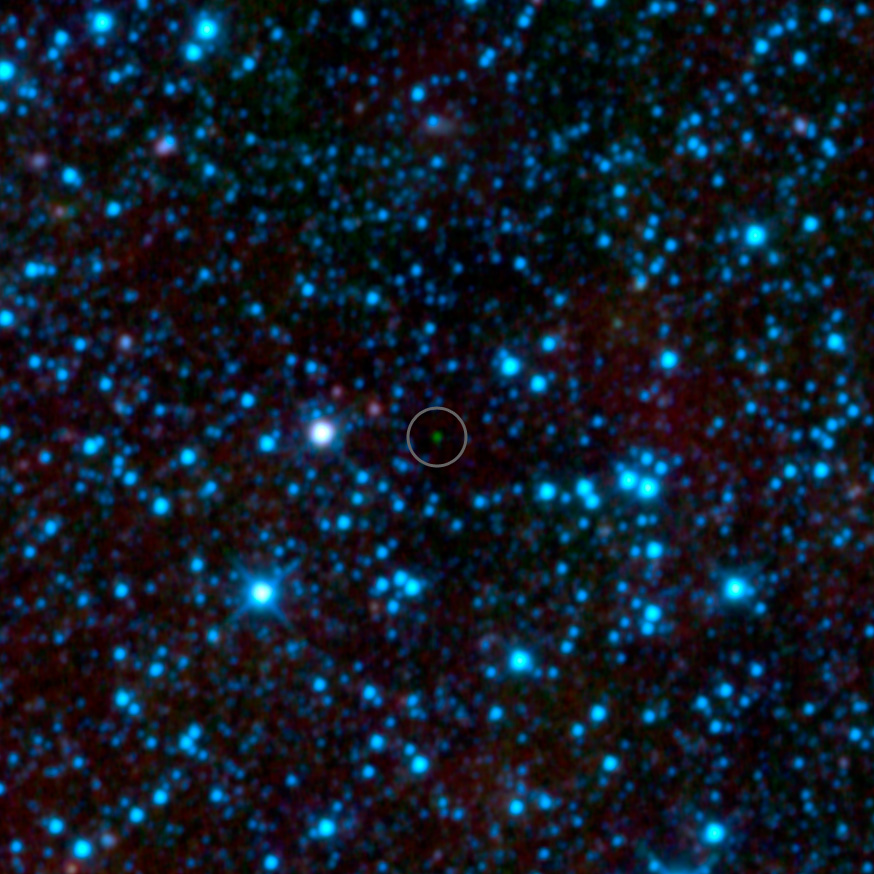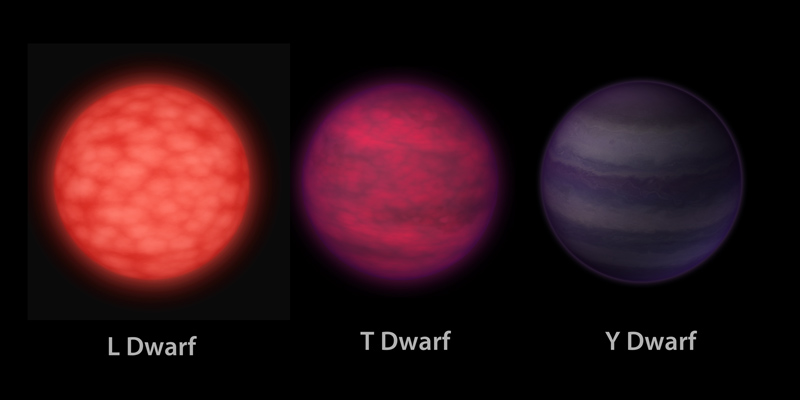NASA JPL-Caltech | WISE | 2011 Aug 23
Scientists using data from NASA's Wide-field Infrared Survey Explorer (WISE) have discovered the coldest class of star-like bodies, with temperatures as cool as the human body.(Credit: NASA/JPL-Caltech/UCLA/WISE Team)
Astronomers hunted these dark orbs, termed Y dwarfs, for more than a decade without success. When viewed with a visible-light telescope, they are nearly impossible to see. WISE's infrared vision allowed the telescope to finally spot the faint glow of six Y dwarfs relatively close to our sun, within a distance of about 40 light-years.
"WISE scanned the entire sky for these and other objects, and was able to spot their feeble light with its highly sensitive infrared vision," said Jon Morse, Astrophysics Division director at NASA Headquarters in Washington. "They are 5,000 times brighter at the longer infrared wavelengths WISE observed from space than those observable from the ground."
The Y's are the coldest members of the brown dwarf family. Brown dwarfs are sometimes referred to as "failed" stars. They are too low in mass to fuse atoms at their cores and thus don't burn with the fires that keep stars like our sun shining steadily for billions of years. Instead, these objects cool and fade with time, until what little light they do emit is at infrared wavelengths.
Astronomers study brown dwarfs to better understand how stars form, and to understand the atmospheres of planets beyond our solar system. The atmospheres of brown dwarfs are similar to those of gas-giant planets like Jupiter, but they are easier to observe because they are alone in space, away from the blinding light of a parent star.
So far, WISE data have revealed 100 new brown dwarfs. More discoveries are expected as scientists continue to examine the enormous quantity of data from WISE. The telescope performed the most advanced survey of the sky at infrared wavelengths to date, from Jan. 2010 to Feb. 2011, scanning the entire sky about 1.5 times.
Of the 100 brown dwarfs, six are classified as cool Y's. One of the Y dwarfs, called WISE 1828+2650, is the record holder for the coldest brown dwarf, with an estimated atmospheric temperature cooler than room temperature, or less than about 80 degrees Fahrenheit (25 degrees Celsius).
"The brown dwarfs we were turning up before this discovery were more like the temperature of your oven," said Davy Kirkpatrick, a WISE science team member at the Infrared Processing and Analysis Center at the California Institute of Technology in Pasadena, Calif. "With the discovery of Y dwarfs, we've moved out of the kitchen and into the cooler parts of the house."
Kirkpatrick is lead author of a paper appearing in the Astrophysical Journal Supplement Series, describing the 100 confirmed brown dwarfs. Michael Cushing, a WISE team member at NASA's Jet Propulsion Laboratory in Pasadena, Calif., is lead author of a paper describing the Y dwarfs in the Astrophysical Journal.
The Y dwarfs are in our sun's neighborhood, from approximately nine to 40 light-years away. The Y dwarf approximately nine light-years away, WISE 1541-2250, may become the seventh closest star system, bumping Ross 154 back to eighth. By comparison, the star closest to our solar system, Proxima Centauri, is about four light-years away.
"Finding brown dwarfs near our sun is like discovering there's a hidden house on your block that you didn't know about," Cushing said. "It's thrilling to me to know we've got neighbors out there yet to be discovered. With WISE, we may even find a brown dwarf closer to us than our closest known star."
Once the WISE team identified brown dwarf candidates, they turned to NASA's Spitzer Space Telescope to narrow their list. To definitively confirm them, the WISE team used some of the most powerful telescopes on Earth to split apart the objects' light and look for telltale molecular signatures of water, methane and possibly ammonia. For the very coldest of the new Y dwarfs, the team used NASA's Hubble Space Telescope. The Y dwarfs were identified based on a change in these spectral features compared to other brown dwarfs, indicating they have a lower atmospheric temperature.
The Discovery of Y Dwarfs Using Data from the Wide-field Infrared Survey Explorer (WISE) - MC Cushing et al
- arXiv.org > astro-ph > arXiv:1108.4678 > 23 Aug 2011
- arXiv.org > astro-ph > arXiv:1108.4677 > 23 Aug 2011
<< Previous WISE Image
NASA Satellite Finds Coldest, Darkest Stars Yet
Wired Science | Danielle Venton | 2011 Aug 23
WISE Discovers Some Really “Cool” Stars!
Universe Today | Tammy Plotner | 2011 Aug 24
WISE: Coolest Brown Dwarfs Yet
Centauri Dreams | Paul Gilster | 2011 Aug 25
How Cold Is a Y Dwarf Star? Even You Are Warmer
Space.com | Charles Q Choi | 2011 Aug 25
Coldest 'Missing Link' Brown Dwarf Discovered
Discovery News | Ian O'neill | 2011 Aug 25





